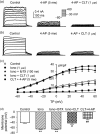Cell cycle-dependent expression of potassium channels and cell proliferation in rat mesenchymal stem cells from bone marrow
- PMID: 17877608
- PMCID: PMC6496559
- DOI: 10.1111/j.1365-2184.2007.00458.x
Cell cycle-dependent expression of potassium channels and cell proliferation in rat mesenchymal stem cells from bone marrow
Abstract
Objective: Recently, our team has demonstrated that voltage-gated delayed rectifier K(+) current (IK(DR)) and Ca(2+)-activated K(+) current (I(KCa)) are present in rat bone marrow-derived mesenchymal stem cells; however, little is known of their physiological roles. The present study was designed to investigate whether functional expression of IK(DR) and I(KCa) would change with cell cycle progression, and whether they could regulate proliferation in undifferentiated rat mesenchymal stem cells (MSCs).
Materials and methods: Membrane potentials and ionic currents were recorded using whole-cell patch clamp technique, cell cycling was analysed by flow cytometry, cell proliferation was assayed with DNA incorporation method and the related genes were down-regulated by RNA interference (RNAi) and examined using RT-PCR.
Results: It was found that membrane potential hyperpolarized, and cell size increased during the cell cycle. In addition, IK(DR) decreased, while I(KCa) increased during progress from G(1) to S phase. RT-PCR revealed that the mRNA levels of Kv1.2 and Kv2.1 (likely responsible for IK(DR)) reduced, whereas the mRNA level of KCa3.1 (responsible for intermediate-conductance I(KCa)) increased with the cell cycle progression. Down-regulation of Kv1.2, Kv2.1 or KCa3.1 with the specific RNAi, targeted to corresponding gene inhibited proliferation of rat MSCs.
Conclusion: These results demonstrate that membrane potential, IK(DR) and I(KCa) channels change with cell cycle progression and corresponding alteration of gene expression. IK(DR) and intermediate-conductance I(KCa) play an important role in maintaining membrane potential and they participate in modulation of proliferation in rat MSCs.
Figures





Similar articles
-
Potassium channel currents in rat mesenchymal stem cells and their possible roles in cell proliferation.Clin Exp Pharmacol Physiol. 2008 Sep;35(9):1077-84. doi: 10.1111/j.1440-1681.2008.04964.x. Epub 2008 May 25. Clin Exp Pharmacol Physiol. 2008. PMID: 18505444
-
Properties of ion channels in rabbit mesenchymal stem cells from bone marrow.Biochem Biophys Res Commun. 2006 Sep 15;348(1):301-9. doi: 10.1016/j.bbrc.2006.07.054. Epub 2006 Jul 20. Biochem Biophys Res Commun. 2006. PMID: 16876113
-
Ion channels in mesenchymal stem cells from rat bone marrow.Stem Cells. 2006 Jun;24(6):1519-28. doi: 10.1634/stemcells.2005-0307. Epub 2006 Feb 16. Stem Cells. 2006. PMID: 16484345
-
Mesenchymal stem cell differentiation: Control by calcium-activated potassium channels.J Cell Physiol. 2018 May;233(5):3755-3768. doi: 10.1002/jcp.26120. Epub 2017 Sep 7. J Cell Physiol. 2018. PMID: 28776687 Review.
-
Physiological Roles and Therapeutic Potential of Ca2+ Activated Potassium Channels in the Nervous System.Front Mol Neurosci. 2018 Jul 30;11:258. doi: 10.3389/fnmol.2018.00258. eCollection 2018. Front Mol Neurosci. 2018. PMID: 30104956 Free PMC article. Review.
Cited by
-
KCa3.1/IK1 Channel Regulation by cGMP-Dependent Protein Kinase (PKG) via Reactive Oxygen Species and CaMKII in Microglia: An Immune Modulating Feedback System?Front Immunol. 2015 Apr 8;6:153. doi: 10.3389/fimmu.2015.00153. eCollection 2015. Front Immunol. 2015. PMID: 25904916 Free PMC article.
-
KCa3.1 Channels Promote Cardiac Fibrosis Through Mediating Inflammation and Differentiation of Monocytes Into Myofibroblasts in Angiotensin II -Treated Rats.J Am Heart Assoc. 2019 Jan 8;8(1):e010418. doi: 10.1161/JAHA.118.010418. J Am Heart Assoc. 2019. PMID: 30563389 Free PMC article.
-
A large-conductance (BK) potassium channel subtype affects both growth and mineralization of human osteoblasts.Am J Physiol Cell Physiol. 2009 Dec;297(6):C1397-408. doi: 10.1152/ajpcell.00311.2009. Epub 2009 Sep 23. Am J Physiol Cell Physiol. 2009. PMID: 19776394 Free PMC article.
-
Diversity of ion channels in human bone marrow mesenchymal stem cells from amyotrophic lateral sclerosis patients.Korean J Physiol Pharmacol. 2008 Dec;12(6):337-42. doi: 10.4196/kjpp.2008.12.6.337. Epub 2008 Dec 31. Korean J Physiol Pharmacol. 2008. PMID: 19967076 Free PMC article.
-
Functional ion channels in stem cells.World J Stem Cells. 2011 Mar 26;3(3):19-24. doi: 10.4252/wjsc.v3.i3.19. World J Stem Cells. 2011. PMID: 21607133 Free PMC article.
References
-
- Bruder SP, Jaiswal N, Haynesworth SE (1997) Growth kinetics, self‐renewal, and the osteogenic potential of purified human mesenchymal stem cells during extensive subcultivation and following cryopreservation. J. Cell. Biochem. 64, 278–294. - PubMed
-
- Cahalan MD, Wulff H, Chandy KG (2001) Molecular properties and physiological roles of ion channels in the immune system. J. Clin. Immunol. 21, 235–252. - PubMed
-
- Cahill KS, Toma C, Pittenger MF, Kessler PD, Byrne BJ (2003) Cell therapy in the heart: cell production, transplantation, and applications. Methods Mol. Biol. 219, 73–81. - PubMed
-
- Caplan AI, Bruder SP (2001) Mesenchymal stem cells: building blocks for molecular medicine in the 21st century. Trends Mol. Med. 7, 259–264. - PubMed
Publication types
MeSH terms
Substances
LinkOut - more resources
Full Text Sources
Miscellaneous

